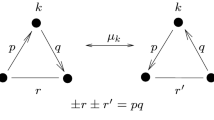Abstract
A quiver mutation loop is a sequence of mutations and vertex relabelings, along which a quiver transforms back to the original form. For a given mutation loop \(\gamma\), we introduce a quantity called a partition q-series \({Z(\gamma)}\) which takes values in \({\mathbb{N}[[q^{1/ \Delta}]]}\) where \(\Delta\) is some positive integer. The partition q-series are invariant under pentagon moves. If the quivers are of Dynkin type or square products thereof, they reproduce so-called fermionic or quasi-particle character formulas of certain modules associated with affine Lie algebras. They enjoy nice modular properties as expected from the conformal field theory point of view.
Similar content being viewed by others
References
Cecotti, S., Neitzke, A., Vafa, C.: R-twisting and 4d/2d correspondences. arXiv:1006.3435 [preprint] (2010)
Feigin B., Stoyanovsky A.: Quasi-particles models for the representations of Lie algebras and geometry of flag manifold. Funct. Anal. Appl. 28(1), 68–90 (1994)
Fomin S., Zelevinsky A.: Cluster algebras I: Foundations. J. Am. Math. Soc. 15(2), 497–529 (2002)
Fomin S., Zelevinsky A.: Cluster algebras IV: Coefficients. Compositio Mathematica 143(01), 112–164 (2007)
Georgiev G.: Combinatorial constructions of modules for infinite-dimensional Lie algebras, I. Principal subspace. J. Pure Appl. Algebra 112(3), 247–286 (1996)
Georgiev, G.: Combinatorial constructions of modules for infinite-dimensional Lie algebras, II. Parafermionic space. q-alg/9504024 [preprint] (1995)
Hatayama G., Kirillov A.N., Kuniba A., Okado M., Takagi T., Yamada Y.: Character formulae of \({\widehat{sl}_{n}}\)-modules and inhomogeneous paths. Nucl. Phys. B 536(3), 575–616 (1998)
Kač V.G., Peterson D.H.: Infinite-dimensional Lie algebras, theta functions and modular forms. Adv. Math. 53, 125–264 (1984)
Kedem R., Klassen T., McCoy B., Melzer E.: Fermionic quasi-particle representations for characters of \({(G^{(1)})_{1} \times (G^{(1)})_{1}/(G^{(1)})_{2}}\). Phys. Lett. B 304(3), 263–270 (1993)
Keller B.: The periodicity conjecture for pairs of Dynkin diagrams. Ann. Math. (2) 177(1), 111–170 (2013)
Kuniba A., Nakanishi T., Suzuki J.: Characters in conformal field theories from thermodynamic Bethe ansatz. Modern Phys. Lett. A 8(18), 1649–1659 (1993)
Lepowsky J., Primc M.: Structure of the standard modules for the affine Lie algebra \({A^{(1)}_1}\), volume 46 of Contemporary Mathematics. American Mathematical Society, Providence (1985)
Stoyanovsky A., Feigin B.: Functional models for representations of current algebras and semi-infinite Schubert cells. Funct. Anal. Appl. 28(1), 55–72 (1994)
Terashima Y., Yamazaki M.: 3d N = 2 theories from cluster algebras. Prog. Theor. Exp. Phys. 023, B01 (2014)
Terhoeven, M.: Lift of dilogarithm to partition identities. hep-th/9211120 [preprint] (1992)
Zagier, D.: The dilogarithm function. In: Frontiers in number theory, physics, and geometry II, pp. 3–65. Springer, Berlin (2007)
Author information
Authors and Affiliations
Corresponding author
Additional information
Communicated by P. T. Chruściel
Rights and permissions
About this article
Cite this article
Kato, A., Terashima, Y. Quiver Mutation Loops and Partition q-Series. Commun. Math. Phys. 336, 811–830 (2015). https://doi.org/10.1007/s00220-014-2224-5
Received:
Accepted:
Published:
Issue Date:
DOI: https://doi.org/10.1007/s00220-014-2224-5



